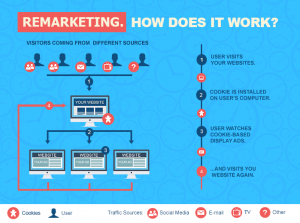Totally, completely, utterly lost when you hear the word “remarketing”? No one blames you; it’s  a tough concept … but necessary. Also called retargeting, this ad strategy is effective for a wide range of business types, so you should definitely take the time to get the concept down.
a tough concept … but necessary. Also called retargeting, this ad strategy is effective for a wide range of business types, so you should definitely take the time to get the concept down.
Below we’ll discuss each step in the remarketing process, as well as ways you can improve your remarketing effectiveness, giving you the best chance of grabbing those prospects and turning them into customers.
1. User Visits Your Website
A user comes to your website due to a recommendation, a web search or some other means. Most users click around and leave again, but you can up the chances they’ll remember you with a clear value proposition and appealing color scheme.
2. Your Site Installs a Cookie on User’s Browser
While they are visiting, your site installs a cookie, or small bit of code, in the user’s browser, telling it the user has visited you.
3. Cookie Prompts Your Ads
The cookies installed in the user’s browser then affect which ads they view. When they visit another website, for instance, your ad is more likely to pop up in the top banner or the sidebar, where that website has made space for advertisements. The user sees your ad on multiple websites and in search as well. The more attention-grabbing your ad is, the greater chance of that visitor coming to your site again.
4. User Visits You Once More
After seeing enough of your ads, the user is likely to come back to your site. This time, you can be ready with appealing design, clear calls-to-action, deals and steals, coupons or other incentives to buy.
Still confused? We didn’t think so. It’s actually a pretty simple concept when you break it down. Now that you understand it, you can get started today creating better, more effective ads and growing your customer base for long-term success.

